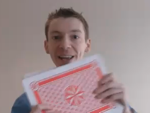 In the previous post, I featured James Grime's Last To Be Chosen video, where we learned about the Kruskal Count, and discussed some variations.
In the previous post, I featured James Grime's Last To Be Chosen video, where we learned about the Kruskal Count, and discussed some variations.
Today, you'll see James Grime's explanation, and learn a little bit more about how this works. I'll also discuss variations after the video explanation itself.
If you haven't watched James Grime's video from the previous post, please watch that first. Here's his explanation of the Kruskal Count:
Beyond the explanation itself, let's start with the fact that about 58% of the time, every single one of the first 10 cards will always lead to the predicted card. This fact can come in handy!
For example, if you can reasonably work in a pre-arranged deck when presenting this, and you've checked that the first 10 cards all lead to the same card, you could have a prediction card ready. In an informal performance, however, you're better off using a shuffled deck and playing the percentages.
See how the average value affects the card? When jacks, queens, and kings are respectively counted as 11, 12, and 13, the odds of this trick working go down to 66% - only 2 times out of 3! Notice that the spelling variation shoots the odds up to 96.5%!
Why? If a card is randomly pulled out of the deck, its value is most likely to spell with four letters. 20 out of the 52 cards spell with four-letter values (four, five, nine, jack, and king), for a roughly 38.5% chance. The other 32 are split evenly between three-letter values (ace, two, six, and ten) and five-letter values (three, seven, eight, and queen), giving a roughly 30.75% chance of appearing.
This is why the clock version from the previous post works so reliably, despite having such a short chain. Even though eleven and twelve have more letters, the only chance you really have to spell them is on your first choice. After that, the process doesn't let you land on 11 or 12, so you don't get any other chance to spell them.
We discussed a few other places to apply this principle in the previous post, such as book and poem passages, as well as clocks. With a better understanding of the formulas and percentages, what other variations are there?
Try experimenting with the following idea. Since we know that spelling the values increases the odds so well that it can work with a short circular chain such as a clock, what would happen if you used just the 13 cards of 1 suit, and allowed spelling in a circular chain by moving 1 card to the bottom for each letter? What patterns can you find if they're in Ace through King order? How about King through Ace order? Are there any usable patterns if those 13 cards from the same suit are shuffled? Jim Steinmeyer's book Impuzzibilities contains a very nice presentation using an approach like this.
Imagine this: You remove two decks of cards in their cases, one red-backed and one blue-backed, and you set one aside, explaining that you've reversed one card in that one as a prediction. You then have the person shuffle the other deck, and go through the procedure as described. After they go through the entire deck, but haven't mentioned their card, you remove the reverse card from the other deck, reminding them that this prediction has been in the box since before they even shuffled the deck! You ask them what their last card chosen was, and it proves to be the same as the reversed card!
How is this possible? You need a tool from a magic shop known as a Brainwave deck. I won't reveal the secret here. The basic idea of a Brainwave deck is that it's specially prepared to allow you to show any card as the only face-down card in the deck (and even a different back color). Once you use the Kruskal count procedure to determined the likely card chosen, you know which card to show face down.
There is a similar tool known as the Invisible Deck, but the card would be shown face-up. For this routine, I think the added suspense of being able to keep the card face-down helps the routine. Those who've been into magic will probably also know of many variations of these routines (such as Kolossal Killer or Heirloom) that could be used here, as well.
I'd like to hear about any variations you develop, as well!
Update [12/17/10]: James Grime has just published a detailed paper on Kruskal's Count. It's an early draft, so he warns that there may be a few mistakes. Check it out!




No Response to "Last To Be Chosen II"
Post a Comment